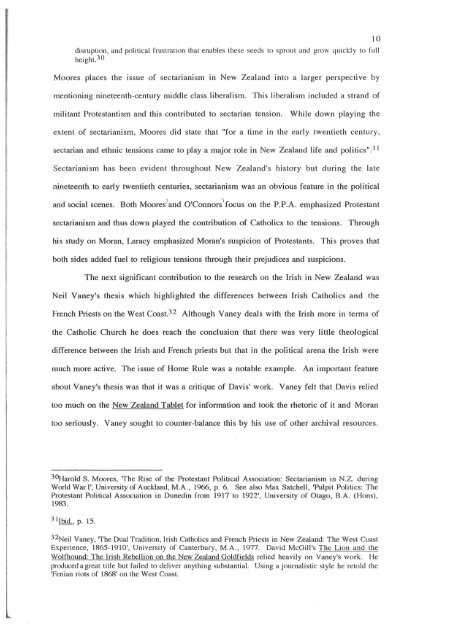TRANSPLANTED IRISH INSTITUTIONS - University of Canterbury
TRANSPLANTED IRISH INSTITUTIONS - University of Canterbury
TRANSPLANTED IRISH INSTITUTIONS - University of Canterbury
You also want an ePaper? Increase the reach of your titles
YUMPU automatically turns print PDFs into web optimized ePapers that Google loves.
disruption, and political frustration that enables these seeds to sprout and grow quickl y to full<br />
hcight. 30<br />
Moores places the issue <strong>of</strong> sectarianism In New Zealand into a larger perspective by<br />
mentioning nineteenth-century middle class liberalism. This liberalism included a strand <strong>of</strong><br />
militant Protestantism and this contributed to sectarian tension. While down playing the<br />
extent <strong>of</strong> sectarianism, Moores did state that "for a time in the early twentieth century,<br />
sectarian and ethnic tensions came to playa major role in New Zealand life and politics")l<br />
Sectarianism has been evident throughout New Zealand's history but during the late<br />
nineteenth to early twentieth centuries, sectarianism was an obvious feature in the political<br />
and social scenes. Both Moores)and O'Connors)focus on the P.P.A. emphasized Protestant<br />
sectarianism and thus down played the contribution <strong>of</strong> Catholics to the tensions. Through<br />
his study on Moran, Laracy emphasized Moran's suspicion <strong>of</strong> Protestants. This proves that<br />
both sides added fuel to religious tensions through their prejudices and suspicions.<br />
The next significant contribution to the research on the Irish in New Zealand was<br />
Neil Yaney's thesis which highlighted the differences between Irish Catholics and the<br />
French Priests on the West Coast. 32 Although Yaney deals with the Irish more in terms <strong>of</strong><br />
the Catholic Church he does reach the conclusion that there was very little theological<br />
difference between the Irish and French priests but that in the political arena the Irish were<br />
much more active. The issue <strong>of</strong> Home Rule was a notable example. An important feature<br />
about Yaney's thesis was that it was a critique <strong>of</strong> Davis' work. Yaney felt that Davis relied<br />
too much on the New Zealand Tablet for information and took the rhetoric <strong>of</strong> it and Moran<br />
too seriously. Yaney sought to counter-balance this by his use <strong>of</strong> other archival resources.<br />
10<br />
3DJ;arold S. Moores, The Rise <strong>of</strong> the Protestant Political Association: Sectarianism in N.Z. during<br />
World War I', <strong>University</strong> <strong>of</strong> Auckland, M.A., 1966, p. 6. See also Max Satchell, 'Pulpit Politics: The<br />
Protestant Political Association in Dunedin from 1917 to 1922', <strong>University</strong> <strong>of</strong> Otago, B.A. (Hons),<br />
1983.<br />
3 IIbid., p. IS.<br />
32Neil Yaney, The Dual Tradition, Irish Catholics and French Priests in New Zealand: The West Coast<br />
Experience, 1865- 19\0', <strong>University</strong> <strong>of</strong> <strong>Canterbury</strong>, M.A ., 1
















